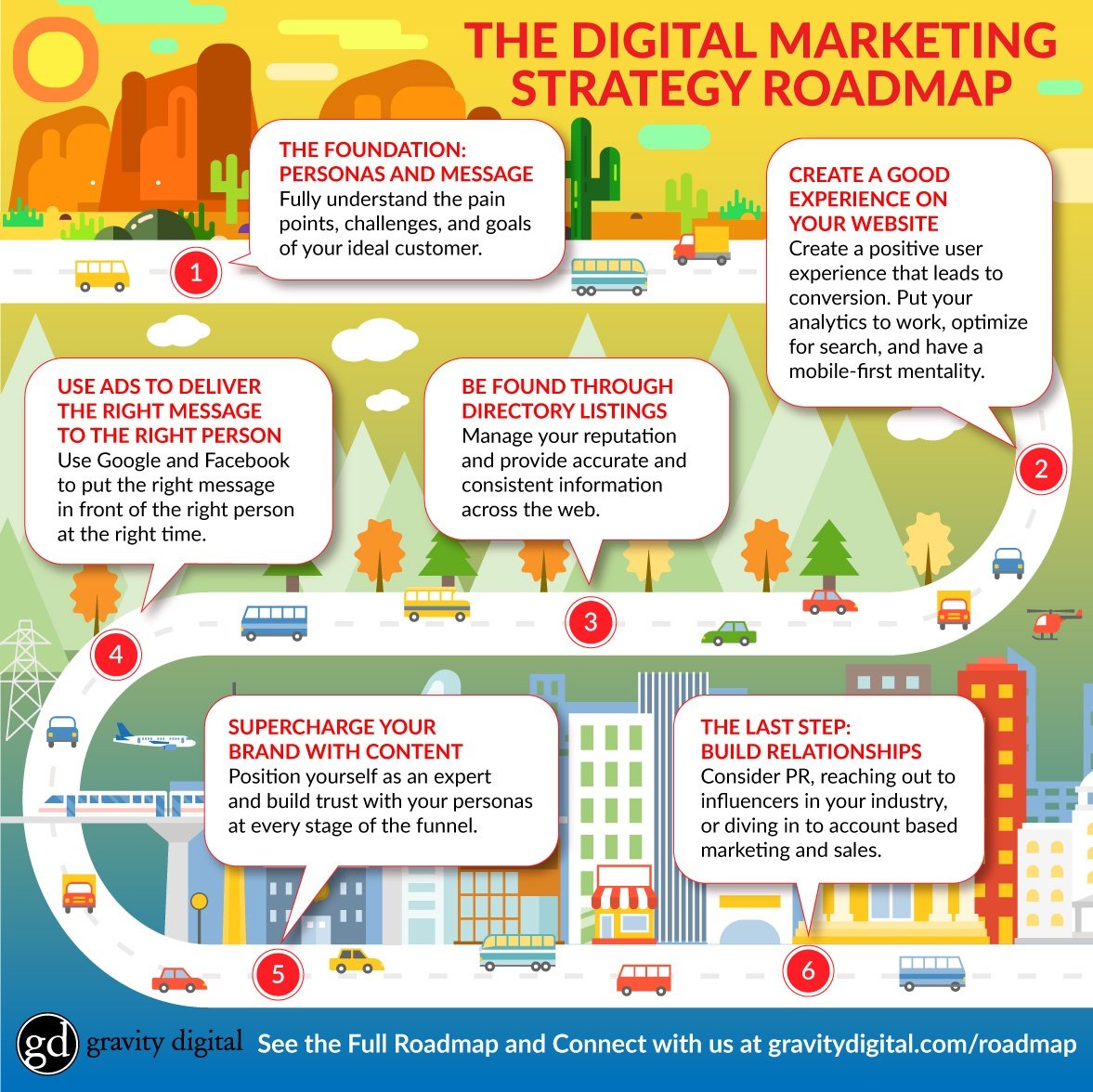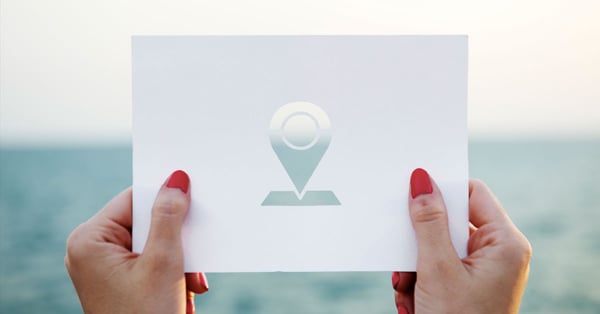I get it.
You want to focus on running your business...
Getting better at what YOU do, not trying to learn how to use a million digital marketing tools or keep up with tactics that seem to change daily.
It’s possible that you’ve wasted a LOT of time, energy, and money on chasing shiny objects that didn’t pan out.
But you see the necessity of having a strong presence online. There's the dilemma.
Let’s take some of the mystery out of it, shall we?
If you’re just starting a new business, I recommend taking the recommendations in this article in order. If you’ve been around for a while, you need to be using actionable metrics to tell you where to put your focus. If you need help with that, check out the transparency we offer in our 90-Day Scale or Bail Campaign.
Let’s jump in!
Digital Marketing Strategy Table of Contents:
The Foundation: Personas and Message
Create a Good Experience on Your Website
Be Found Through Directory Listings
Use Ads to Deliver the Right Message to the Right Person
Supercharge Your Brand with Content
The Last Step: Build Relationships

The Foundation: Personas and Message

Great marketing always has a transformation story at its core. To succeed, you need to know two things:
- What is your ideal customer’s life like before and after using your product or service?
Gather together the people in your business that know your customers the best. Take some time on this. Document it. Revise it regularly. Have your team dive deep on how the life of your customer changes when you enter the picture. Start with basic stuff and then jump into emotions, daily life, and the way their worldview changes. The more fully you understand this person, the more successful you will be in all future marketing activities. - What value does your product/service deliver to that person?
In other words, how can you position yourself as the “vehicle” from your customers before state to their after state?
Create a Good Experience on Your Website

You want more traffic to your website.
But what happens if they have a bad experience when they get there? You will have blown your only shot at a first impression and your chances of getting a new customer will have decreased.
If you’re paying for traffic, then you are wasting money filling up a leaky bucket. We see this all the time.
The goal of the website should be to have a visitor convert in some way: Schedule an appointment, buy a product, start a conversation with a sales rep, subscribe, or download a resource. If your website isn’t converting, what is its purpose? Here are a few strategies to consider:
- Make it easy to get to the most important areas of your site.
Remove clutter, use white space, and put the most important information and links front and center. In addition, tell your visitors what it is you want them to do when they arrive on a specific page.
Place relevant calls-to-action in places where it is natural to take the next step in the customer journey.
Every page on your site should have a goal and a clear action that a visitor can take. - Let your customer’s transformation story guide your messaging.
Take the work that you did when you researched your customer and allow your site to help visitors envision the “after state” that your product or service provides.
Remember that your customer is the hero. Speak to their needs. Don’t make them wade through pages of company information to find out what you can do for them. Trust me, they won’t stick around that long. - Collect data from your website visitors and regularly check it to improve your user experience and conversion rate.
There are some free tools that can help with this.
Google Analytics is the best source of data for your website and it comes with free courses to help you learn how to use it.
Decide what metrics are important to you and assign someone to be responsible for tracking them weekly. - Make it look good on mobile.
“Responsive design” was once an option that web designers offered. Now, 60% of searches are performed on mobile. If they aren’t already, the majority of people will soon be looking at your website on their phone, not their computer. Have a mobile-first mentality.
Be Found Through Directory Listings

Your website is your “home base” online, but companies with brick-and-mortar only locations see an average of 2.7x more traffic across third party services than their own website.
If you operate your business out of a physical location, it is imperative that you “own” all of your directory listings. There are literally hundreds of these listing sites, but you should focus on the big ones (Google My Business, Facebook) and any others that are specific to your audience.
The reality is that they probably already exist but may have bad information. These sites scrape data from across the web and use crowd sourced information and suggestions to create listings for your business. Google sees it as a positive sign if the data from these listings is consistent. If you claim all of your listings you can:
- Provide Consistent and Accurate information across the web and send positive signals to Google.
- Use these listings to engage with users and promote marketing messages.
- Monitor and manage your reputation by reviewing and responding to reviews.
- Look like you’ve got it together.
Use Ads to Deliver the Right Message to the Right Person

Ads are still the biggest bang for your buck and the easiest way to get quick wins, but if you are like us, you really like some ads and hate others.
The difference usually comes down to context. When we see ads that are helpful or relevant to our lives and interests, we like it. When we are bombarded by mass messages that are not relevant or helpful, they can be very annoying.
The key to success is having a firm grasp on your personas and message and using that knowledge to guide the offer or content that you are promoting.
There are a lot of ad networks available to marketers, but we recommend starting with the two most powerful:
-
There are so many options available to marketers who use Google.
You can run paid search ads, you can run ads on the Google Display Network of more than 2 million websites, you can run ads on YouTube, and you can even run ads in Gmail.
What really makes it all work is Google’s intelligence. They know user’s search history, so you can put your message in front of people with specific interests, people with active in-market searches for your type of product or service, people that visit specific websites, people who have been to your website, people who have viewed your YouTube videos, etc.
Many businesses have tried advertising with Google and have failed because they didn’t take the time to learn how to use the tool. We recommend taking some of the free courses available through the academy. If you take the time to learn it, you will have success.
-
Facebook has 2 Billion monthly users...
and like Google, they have a lot of data about their users and there are very advanced targeting options available to marketers.
Facebook owns Instagram as well, so that network is available through the same platform. Like Google, Facebook has an academy where you can learn best practices that will lead to success.
Facebook Video Ads are the foundation of our 90-Day Scale or Bail Campaign.
In order to run ads, you will need some resources for design. Fortunately, design tools have become very democratized and easy to use. Check out our post on 3 Free Image and Design Tools.
Supercharge Your Brand with Content

Content is what separates the contenders from the pretenders.
Consumers have come to expect that the brands they interact with online will have something to offer them before they begin a conversation.
By providing content through your blog, email, newsletter, or your YouTube or social media channels, you are positioning yourself as an expert and building trust. Content also allows you to connect emotionally with consumers or demonstrate who you are as a brand. Use content to educate, inform, entertain, or inspire: Just remember to make it relevant to your persona’s life.
Place your content where your persona spends time. Are you B2B? Use LinkedIn. Do you have a young customer base? Instagram is the go-to… or TikTok if you’re bold enough.
The Last Step: Build Relationships

Are you still with me?
You must be serious about this.
If you’ve checked all of the boxes up to this point, you may begin your digital conquest by nurturing relationships that can expand your reach and accelerate your growth. Here are three ways to explore:
-
Depending on your type of business, public relations may be a logical next step.
By reaching out to news outlets or local events, you may be able to get some free coverage that can connect you with new audiences. You will need to have a good story to tell in order to attract this kind of attention.
-
Influencer marketing is another way that your brand can reach new audiences.
A little research will be required to find out who the top voices are online for your industry. Who are your personas engaging with in their newsfeed? Once you’ve identified these influencers, reach out and ask about collaboration opportunities.
-
This simplest and most important relationships to nurture are your current customers. You know the ones who love you. Ask them to leave you a review or give you a testimonial that you can promote. If it’s right for your business, consider creating an affiliate or referral rewards program.
We have a saying when we onboard a new client: “Begin as you mean to go”.
If you are just starting your digital marketing efforts, keep this idea in front of you.
Start by knowing your personas and your message, build a great website that converts, drive traffic, and build relationships.
Know what the goal is for each action that you take and track your results.
Keep learning.
Consumer behavior and technology change rapidly, so keep educating yourself and stay relevant.
 About the Author
Matt Brannon
About the Author
Matt Brannon
Matt graduated from Baylor University in 2003 and married his college sweetheart Ginny. They moved to Austin and Matt began working for Governor Rick Perry, first as an Advance Man and then later as the Governor’s Executive Aide. In 2007, Matt and Ginny moved to Los Angeles where Matt worked in public relations for an independent film (and Toronto Film Fest winner), “Bella”. His primary role was implementing grassroots efforts on a new online network called “Facebook”. After the promotion of Bella came to an end, Matt worked various jobs in entertainment and also spent 5 years working at Cedars-Sinai hospital. in 2013, Matt and Ginny moved back to their home state of Texas and joined the team at Gravity Digital. Matt’s distinctive value for his clients is his ability to bring out-of-the-box ideas and solve problems creatively.
Follow Matt Brannon:
LinkedIn |
Twitter


